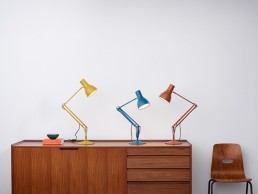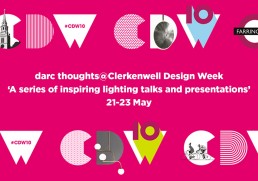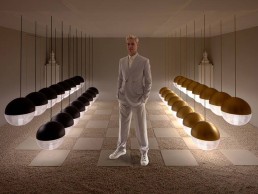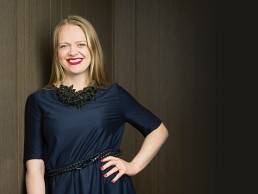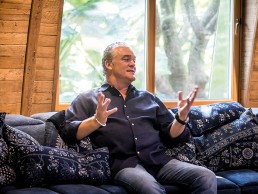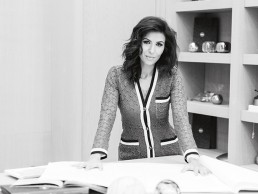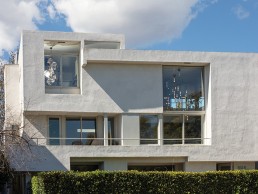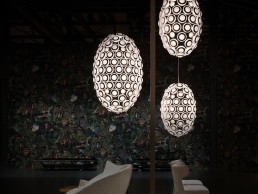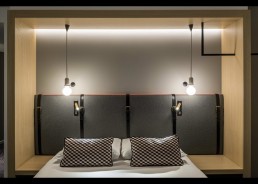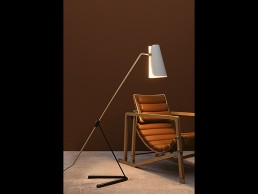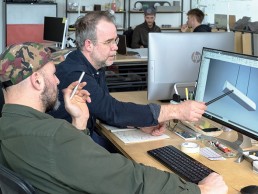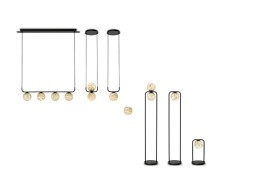New Anglepoise Margaret Howell Collection
(UK) - Anglepoise to renew Margaret Howell collection this summer.
Introducing a smart new Sienna Edition into the Type 75 lighting collection designed by Sir Kenneth Grange, the rich, clay colour chosen by Margaret adds a new dimension to the Margaret Howell colour palette and acts as the perfect complement to existing Yellow Ochre and Saxon Blue desk lamp editions.
Floor standing Type 75 lamps in all three colours will also be added, expanding the Anglepoise + Margaret Howell collection to six pieces and extending its high functionality.
“My choice of Sienna for our new Anglepoise lamp may have been influenced by having recently worked on the Autumn Winter clothing collections," says Howell. "We chose fabrics in rich rusts and warm browns. Sienna, a deep burnt orange, is a strong colour and I think sits well against pale grey and neutral walls.”
The new collection will be available From June 10 2019
www.anglepoise.com / www.margarethowell.co.uk
darc thoughts@Clerkenwell Design Week confirmed
(UK) – darc magazine hosts three-days of talks and presentations focused on lighting within interior design.
Curated by darc’s editor Helen Ankers, the talks programme takes place at Fabric nightclub from 21-23 May as part of this year’s Clerkenwell Design Week’s ‘Light’ exhibition. A mix of project presentations and panel discussions the programme will focus on the importance of lighting design within interiors and architecture, bringing with it leading names from the worlds of interiors and lighting.
darc’s Editor Helen Ankers comments: “The importance of lighting within interior design is undeniable and reflected in the pages of darc magazine each issue. We are seeing the relationship between interior and lighting designers continue to grow when working on projects, with both disciplines able to learn from each other. Through partnering with Clerkenwell Design Week for this year’s lighting talks, we hope to raise the profile of lighting within interior design further and aim to bring a varied and interesting mix of topics to the event.”
Tuesday 21 May
11am – Realising a design vision with architectural and bespoke decorative lighting
An inspiring insight into the collaboration between lighting designers Into and interior designers DesignLSM showing how they realise their collective vision for the lighting on flagship restaurant projects. Darren Orrow (Into Lighting) and Karen Taylor (Design LSM) discuss the design process from initial interiors concept through to the development of a fully integrated architectural lighting scheme, decorative lighting selection and the product design, modelling and manufacture process for bespoke decorative lighting.
1pm – Outdoor Lighting – A Designer’s Guide
Presented by Simeon Chilvers, Manager Director of Cameron Design House and Sally Storey, Creative Director of John Cullen Lighting – learn how to choose decorative lighting for the garden; about clever outdoor lighting techniques; as well as the importance of bespoke outdoor lighting solutions.
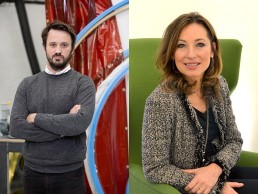
3pm – Design with OLED
Balint Bolygo and Elod Beregszaszi of Kinetech Design explore the design capabilities of OLED and consider how OLED panels can be used to create designs not possible with other light sources. Kinetech will be joined by Sandi Moolman of frequent collaborators, Applelec, who will talk about how the company supports designers using OLED light panels in a variety of applications.
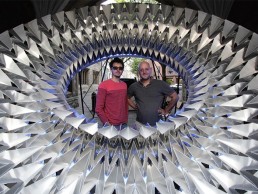
Wednesday 22 May
11am – Women in Design
Light Collective’s Women in Lighting project will meet to discuss the role of women in design. Moderated by WiL UK ambassador Greta Smetoniute of Michael Grubb Studio | Panelists include: Lauren Lever of Foundry; Katia Kolovea of Urban Electric; and Faye Robinson of Enigma Lighting

1pm – The Defining Light of Hospitality
How lighting design is crucial in creating inviting environments within the hotel sector. Moderated by Paul Nulty. Panelists include: Constantina Tsoutsikou of HBA; Roman Zakovsky of Lasvit; Sofia Hagen of DH Liberty; and Tom Hupe of Perkins and Wills.
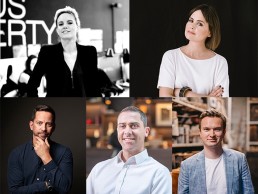
3pm – Lamps for the Neanderthal – Magnus Wastberg
Our DNA has not changed much for the last 300.000 years or so but for the last 50 – 100 years our relationship to light has changed profoundly. Did we lose anything on the way?
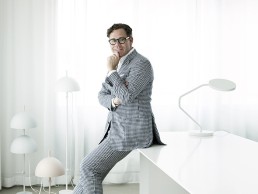
Thursday 23 May
11am – Lighting Your Life
Whether mood enhancing, transitional or developed with people in mind, how residential lighting can do more than just illuminate. Moderated by Harry McKinley | Panelists include: Anna Burles of Run For The Hills; Monique Tollgard of Staffan Tollgard Design Group; and Sanjit Bahra of Design Plus Light.

1pm – Fit for Purpose
Both decorative and purposeful, how function and form align in lighting for bar and restaurant spaces. Moderated by Harry McKinley | Panelists include:Tony Matters of Faber Design; James Roberts of James Roberts Design Studio; and Nick Hoggett of dpa lighting consultants.

For more information visit: Clerkenwell Design Week
Lee Broom 'Park Life' exhibition
(Australia) - British designer Lee Broom creates one of his most significant exhibitions to date through a presentation with Space Furniture.
The installation entitled ‘Park Life’ is set within an underground car park below the flagship showroom of Space Furniture in Australia. The 4,000sqft presentation is the largest show Broom has created to date.
Employing the urban surroundings of the location, Broom has transformed the industrial car park and created a contemporary interpretation of a traditional garden park. Taking the form of a maze, ‘Park Life’ takes guests on a poetic journey of discovery through hidden passageways, featuring sixteen tableaus and vignettes showcasing the brand’s lighting, furniture and accessories in a whole new light.
The exhibition takes inspiration from the pleasure gardens of the 18th century, which were laid out with mazes and miniature waterways. These were the places to be seen and to see the latest in art, architecture, music and illuminations. In much the same way that visitors were entertained in pleasure gardens centuries ago, this modernist interpretation creates a sense of escapism, amusement and drama for which Broom’s shows are best-known for.
In line with the brand’s continuing global expansion, Broom undertook a tour of the region for the whole month of March, presenting a series of Design Talks in Singapore, Brisbane, Sydney and Melbourne coinciding with Singapore and Melbourne Design Weeks.
The 'Park Life' installation at Space in Sydney debuts a new version of Broom’s award-winning Eclipse lights in a polished gold finish. Eclipse has a sculptural silhouette with a mobile-like quality that changes at every angle. Mirror-polished gold and acrylic discs interact, dissect and obscure, which both eclipses and reveals its illumination to the viewer at the same time. The new gold finish transforms the light into a warmer, softer interpretation of the original polished chrome finish.
Eclipse in polished gold will be available as a single pendant light, chandelier and a table lamp available to order from April for delivery in Summer 2019. Lee Broom is available exclusively from Space Furniture in Australia, Singapore and Malaysia.
Lee Broom commented: “I am delighted to return to Australia to present this exciting exhibition with Space Furniture and visit Singapore for the first time during Singapore Design Week. Australia has been a big supporter of my work for many years and it is an honour to create such a significant installation to showcase my collection in Sydney.”
The Emotional Power of Light
Interior designer Jo Littlefair explores the use of light within interiors and how decorative lighting is adopting a more organic aesthetic through sculptural pieces.
“Growing up on a farm in the north-east of England makes the long, dark nights and mornings of the early part of the year feel very familiar. The sense of something cold and mysterious enveloping you can be overwhelming, particularly once the bright lights of Christmas have been packed away, making any glimpses of watery-bright sunshine in the winter sky very welcome. Fire, and the heat and light it gives off, also has a subliminal effect on us all. I believe there is an age-old connection between our emotional state and the presence of a flickering candle to soothe our souls. Like many people, I love the ebb and flow of a fire and the warm light it casts.
My own path into interior design came about by studying textile design as a degree, followed by a long spell of travelling, which concluded with working on a highly-designed ‘super yacht’. This was the first time I’d really seen anything quite so opulent and, whilst it might not have been to my personal taste, it inspired me to pursue a career that allowed me to curate interiors. Three-dimensional structures have always fascinated me too, as well as anything that involved constructing things out of fabrics and threads, paper and metal. If I could bend, burn or sew it, I was hooked!
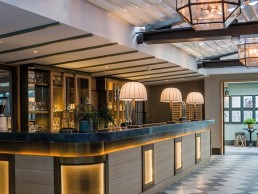
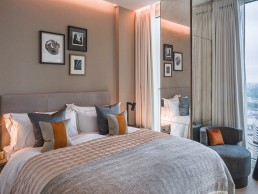
When it came to designing full interior schemes, I immediately recognised the power of light as an essential layer for creating a successful space – adding an accent, highlight or stroke of iridescence that are little short of gifts for an interior designer. Light allows us to make certain elements prominent and knock some things back. It can be functional, but also purely decorative. It is always one of the key things our clients are concerned about – ‘but what about the lighting? – they will ask, which shows how important getting the right light has become and how aware we all are now of its creative, mood-enhancing abilities.
It’s an important and never-ending lesson for designers to discern what makes certain spaces feel welcoming, inspiring or surprising and others cold, hostile and deflating, so that we can design according to how we want people to feel in a space. The trend for lighting the bottom of kitchen islands, so that they look like rockets about to take off baffles me, for example. Blue light is as cold as it gets and so dated already.
People also dislike feeling exposed by light, thanks to glaring lamps and strip lights set within low ceilings. The ability to dim lights and set moods through programmed settings has been of considerable help in our hotel and restaurant work. Programming timers throughout the day to help lighting shift from morning to midday to evening, ideally tailoring the settings for summer and winter too, so that guests don’t feel overwhelmed by harsh lighting in early hours of the morning yet have enough light to navigate the breakfast bar, is a delicately-balanced but powerful creative asset.
Wellness is such a key topic for developers across both the residential and hotel worlds right now, at a time when market places are crowded with brand names and Instagram accounts clamouring for attention. I believe it’s the environment that is relevant and on point, but which ultimately sets you at ease and where your needs are met, that will capitalise on this feeling. Clients are increasingly aware of their own – and their guests’ – dependency on personal technology and there has been much discussion on recent projects about permitting people to disconnect from devices and plug back into the human race. Mental health is thankfully being increasingly recognised as a critical health issue and, as designers, we need to be fully aware of the emotional impact of the spaces we create. Setting out their proposed range of functions and then lighting accordingly plays a crucial part in that.
Technological advances, including intelligent and interactive lighting, as well as the increasing focus on sustainability within the discipline, have also changed our palette of possibility in an entirely positive way, from the ever-diminishing sizes of available fittings to advances in LEDs, although human intelligence still very much needs to be added to the mix, so that they are all handled in a way that doesn’t then create other problems.
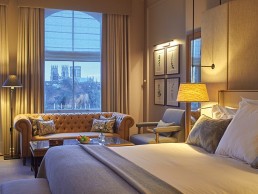
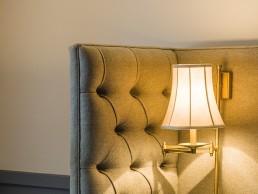
Bowing before new advances simply for the sake of newness is a mistake so often made. For example, we saw the rise in downlights resulting in the overuse of these conveniently-sized fittings. Not only did ceilings look cluttered, but the universal wash of light resulted in interiors without highlights or depth. Spaces often lacked a sense of pace and were simply bland. The effect on the subconscious of overhead lighting is also negative. This type of light is one of the most unflattering and ageing to be seen in, making people feel instantly self-conscious, whilst casting shadows over their faces.
The approach to the lighting of ceilings has to be much more refined – even artistic – concealing fittings where possible so that they wash surfaces and create layering and contrast. If the constraints of a building mean there isn’t adequate height to conceal the fittings, then we make sure instead to create an architectural and bold statement. Sometimes this helps create such a pleasing statement that we do this regardless of the site constraints, such as in the Cluster and Bay show apartments that we designed recently for One Park Drive on Canary Wharf, which won the ‘Residential GOLD Award’ at the 2017 London Design Awards. We created definite slots in the ceiling, which we painted out black, mounting contemporary directional light fittings in them that pick out accents on the walls to wash with light. Highly-textured timber panels on the scheme also conceal built-in storage, designed to echo the exterior façade of the Herzog de Meuron building and the play of this light, and the highlights and shadows it creates, brings out the natural depth of the rich timber, giving the interior the warmth and tactility we sought.
Rafts, hung over a ceiling coffer, are another good way to light ceilings and represent a more contemporary approach to lighting the perimeter of the room. This technique involves dropping a lower section to the centre of the space and adding concealed lighting to the recessed edges of the raft so that it glows, reflects and then washes down the walls. It’s also particularly effective in the corridors of hotels and in entrance halls.
Lighting from the side creates a much more even effect and creates ambience, which can make spaces feel more welcoming and hospitable. Using table and floor lamps to highlight areas of rooms and create light and shade is an incredibly useful tool. The scale and placement of these items is incredibly important. Sometimes, the subtlety of a beautifully-crafted reading lamp that is functional as well as beautiful can add real magic. Or we might create drama and add colour and texture by including a large-scale side lamp. We would always recommend drawing a rough-scale plan and elevation of a table and lamp combination in order to really consider the proportions of pieces. There are general rules when specifying loose lamps, for example, such as matching square lamp bases to square tables and being mindful not to over-scale lampshades so they hang over the edges of tables. There are also times, however when rules are there to be broken, which is why we consider each element in the scheme so carefully!
Recently, we have seen an increase in natural materials trending in decorative lighting. The industrial look, which has been dominant for so long has definitely been superseded by a finer and more elegant approach. Bright, brushed brass juxtaposed against opal glass with marble and timber components often creates an interesting juxtaposition. There is also a more organic aesthetic coming through with sculptural decorative pieces. I feel this has come about as a reaction against the two-dimensional world we swipe and see on our phones day in, day out.
Wherever possible, we try to go back to the theories learnt from those ancient sources of light – candlelight and fires. The presence of nature on my doorstep throughout my childhood was also a huge personal influence and the colours and textures I celebrated with the work I produced in both textile and interior design has always been profoundly important to me. I still hold dear all that nature supplies us with, including the superlative qualities of natural materials such as stone, wood and fibres that have depth, lustre, quality and tactility that seemingly resonate with our very souls – together with lighting that sets them off to perfection.
Timothy Oulton
British designer Timothy Oulton has a passionate quest to create extraordinary spaces. Francesca Barnes delves deeper into what inspires him and what it takes to create something truly unique.
A Benedictine school, an Army dad turned antiques dealer, and an obsession with handcraftsmanship and authentic materials. These are just some of the influences that drive Timothy Oulton in his passionate quest to create extraordinary spaces.
For Oulton, his time as a child spent in a Benedictine monastery in Yorkshire, UK, is where he learnt about community and contributing. “It didn’t matter what you did, as long as you did it to the best of your ability – commit fully to something,” he says.
With no intention of going to university, Oulton’s career began at his father’s antiques shop in Manchester, UK. Having worked there for about three months, the soon-to-be-designer quickly got into the business, amazed at the quality of furniture items that the British made over 300 years – even down to the locks and handles – this is where the obsession began.
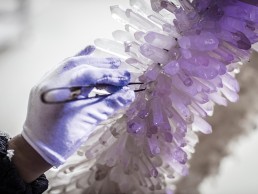
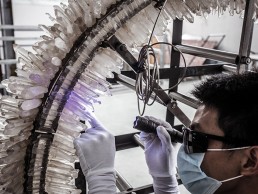
The transition from antiques restoration to designing came about ten years later. Having learnt about craftsmanship and materials from his father’s store, Oulton realised that with antiques, he couldn’t go any further, he couldn’t build the business he wanted or create as he wanted. The antiques business wasn’t scalable and he wouldn’t be able to contribute to other people’s lives.
While Oulton’s time spent in antiques has been of great influence to many of his projects, as a designer of interiors and products, it all starts with the materials. “Antiques on their own are boring,” he says. “Even the best ones, because there’s no point of view. That’s what I like about what we do – we will take an antique-style Chesterfield and then put a bloody great acrylic coffee table in front of it, and that makes it relevant and interesting.
“Inspiration can come from anywhere. As I think Paul Smith says, ‘If you can’t find inspiration in something, you’re not looking hard enough.’ It can come from a flea market, from a friend’s bag… leather finishes have come from cowboy chaps. I see the creative process as a bit of a quest, a journey. You explore, discover and often end up finding inspiration down pretty unexpected avenues.”
Passionate about using salvaged materials, for Oulton, reclaimed materials have an honesty and a purity. What he likes to call a ‘humble luxury’, where the material is unfinished. “I don’t understand people who get reclaimed wood and then varnish it,” he says.
“You should never have started with reclaimed wood in the first place. If you’re going to use reclaimed then show it, don’t lacquer it, don’t wax it. For instance, I love the English Beam console, we don’t plane the beam, we don’t do anything, we just cut massive pleats into it and I think that’s just epic.”
In terms of Oulton’s lighting range, which has continued to gain some momentum in recent years, all of the pieces borrow ideas from the past but with the Timothy Oulton stamp on them. “We take inspiration from Georgian England to Art Deco to mid-century design – classic, vintage forms, but we reinvent them with a modern viewpoint.”
To fully encapsulate his experiences of antiquity, Oulton uses simple tools and time-honoured techniques; the way it was done traditionally. “I think there was a wisdom in the way things were done many years ago that’s still very relevant today,” he says.
“When something has been made by the touch of a craftsman’s hand you get a level of detail and authenticity that you just can’t replicate mechanically. It’s a great feeling to bring that initial concept or inspiration to life, to see it in the flesh. Stories and history are very important to us, the process of bringing a design into being has to have some meaning.
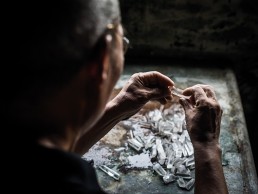
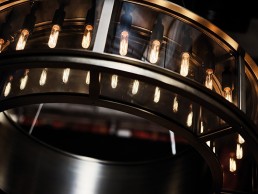
Design isn’t just decoration, it has to be relevant and have meaning,” Oulton continues. “It always comes down to creating a great experience for people – it’s not enough for a design just to look good, it has to make you feel something. I think some of the best design out there is the simplest – simple shapes but made using incredible materials and meticulous attention to detail. We spend countless hours on our hand-finishing but I always say if something’s easy, I’m not interested in doing it.”
For Oulton, the most rewarding part of working within design is the journey – seeing design as a bit of a quest. “It’s a great feeling to bring that initial concept or inspiration to life, to see it in the flesh.
“There are small frustrations along the way but I try not dwell on these, I’m very much one for dusting myself down and taking everything as a learning opportunity. I think that’s the only way you grow… We say that if you’re not prepared to swim upstream, while everyone else is going in the other direction, then you won’t find something that no one else has seen.”
Speaking more generally, Oulton observes that people are now gravitating to layered textures over the minimal Scandinavian look, which has been popular for a while now. “I don’t believe in less is more,” he says. “Once you’re free of the constraints of a minimal approach you can be bolder.”
As well as product design, Oulton and his team are becoming increasingly known for their interior design schemes. One of his most notable projects is considered to be the 1880 members’ club in Singapore. Having designed all 22,000sqft of it, lighting plays a crucial part in the design. Featured in issue 26 of darc, the project brief was to create a space that sparked imaginiation and encouraged unplanned conversations and collisions.
“We wanted the space to be almost unrecognisable after the transformation and the lighting plays a big part in that,” says Oulton. “It was also very important that the different spaces in the club should all feel connected to one another and we used lighting to achieve this. The private dining room is styled quite differently from The Double café bar, but actually the walls between the two spaces can open up, connecting them for larger events. The feature lighting is the same in both areas, which helps tie them together when the space is opened up.”
While the studio has historically focused on decorative lighting in its collection, Oulton explains that they have had to come to grips with architectural lighting as they’ve moved further into designing projects. “Both are about creating an experience and both should complement one another. Sometimes a dramatic light fitting can build out a space, other times there are different forms, spaces and materials that are the star of the show.
“A good example is in the lobby to our showroom. We panelled the walls and ceiling with a collection of 2,000 oak vintage French doors. They were the highlight, and needed some concealed lighting to accentuate their beauty. We always want to create an atmosphere that is comfortable but at the same time makes each individual feel special. It is the details and considered elements of the design that come together to do this and lighting is always an important part of that.”
Impeccably summarising the company’s ethos, Oulton tells darc: “In this virtualised and digitalised world we live in, there is a growing feeling that we really need to reconnect – either with ourselves or with others, and your interior can certainly play a part in this. Whether it’s down time or entertaining, it’s about engaging the senses and feeling alive. That’s an energy that we try to embody in all our products and interiors.”
The Beauty of Bespoke
VISO’s Tzetzy Naydenova explains the benefit of using bespoke lighting in a project and outlines why it’s not always as expensive as you might think.
‘Bespoke’ has come a long way from its first use as an adjective in reference to tailor-made suits. In the design and fabrication industry, the contemporary version of the term refers to any specification characteristic of custom lighting fixtures. Whether it refers to customisation as a service in lighting design or in the form of a special request from the client, bespoke has become the go-to term for anything custom.
An increasing need for differentiation and to create something unique influences how we, as service providers and fabricators, package our offering for both products and service solutions, known at VISO as bespoke solutions. Bespoke requests could be a unique element to an off-the-shelf lighting fixture or fully customised light feature.
In the age of the internet and endless stream of digital inspiration, there is pressure to be creative and to design and fabricate unique products and service offerings. In doing so, designers and architects put their creative signature on each and every project. As a result, the industry has grown more and more wary of picking easily accessible lighting fixture solutions, which casts an additional demand on an already challenging and saturated world of lighting. For example, e-commerce has made products easily accessible all over the world and to everyone. With a quick and easy reverse image search, one can find comparative products for any off-the-shelf offering. The only real solution is to custom create a one-of-a-kind experience to fit the client’s exact needs and wants.
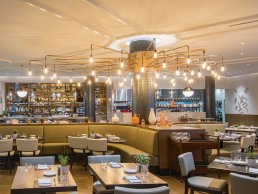
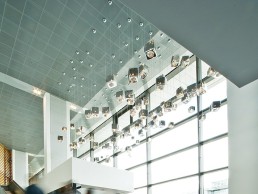
Bespoke
The right light fixture must complement the space and never take away from the design of the interior. The option to customise is especially useful for projects in limited spaces. This was the case for Beaumont Kitchen, a restaurant by Oliver & Bonacini Hospitality group. The O&B group partnered with Saks Fifth Avenue to open a fashionable all-day dining lounge for tired shoppers to take a break. The space for the restaurant contained a weight bearing column in the middle of the restaurant. Our team collaborated with the award-winning design studio, Moncur Design Associates, to create a chandelier that would attach directly to the column. This unique, cost-effective solution saved the client time and affected the environment with such high impact, that the once existing plan to remodel the entire space was not important anymore.
The Myths
“Bespoke must be sky-high pricing. It’s out of budget!” Anytime a client hears bespoke or custom, they think exclusive with budget-breaking prices. It is a well-known fact that lighting retains the smallest budget in a project. Hence, we have to innovate in design, engineering and fabrication to find ways in which we can meet the budget and preserve design intent.
Through design-engineering and vast fabrication capabilities, we optimise the design to fabricate at one-third of the expected or perceived price without compromising design intent. Thus, clients can invest in the visual components of the light fixture that make the most impact. This is an advantage over the status quo and perception that something custom will not meet budget constraints. Our work with polycarbonate, carbon fibre and special metal resin to achieve challenging specifications has proven to be an innovative and cost-effective way to deliver on projects. Modern technology enables us to metalise a variety of materials to simulate glass or metal. It is a complex process, as was the case in our project with Yabu Pushelberg on the Four Seasons Burj Alshaya, Kuwait. Four acoustical metal domes measuring over 2,000mm in diameter were specified for the hotel’s business lounge. Thus, to create a sound-cancellation effect and be within budget, we design engineered the domes and fabricated them out of carbon fibre, finished with a metallic coat made from a special acoustic resin.
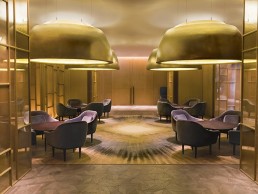
Furthermore, tight and aggressive timelines make bespoke lighting farfetched. We often customise a readily available product to achieve the full project specification. A simple change or upgrade of suspension cables to match clients’ branding or colour palettes can change a design to complement the space as they envisioned it. A minimal, off-the-shelf light pendant can be clustered to compose a substantial bespoke light feature at budget friendly pricing. At the Hilton Hotel, Atlanta, we filled the large three-storey atrium space with an arrangement of over 300 Alo light pendants from the VISO Brand Collection. The result is a custom light feature with an intricate architectural configuration that is visible from each level and from each point of view, thereby making an impact every time guests enter the hotel or exit their rooms.
Despite our efforts to push the boundaries of design-engineering and what is possible to fabricate, the best policy is to inform the client when an element is not possible to fabricate. The right partner is transparent and provides design solutions that fit. The right partner will source the right materials and provide detailed drawings and engineering solutions for challenging one-of-a-kind fabrications. The right partner will provide a deadline for when approvals are required in order to meet all timelines and budgetary constraints.
Bespoke lighting is a rewarding endeavour because no two light fixtures are the same. We are on a mission to help clients transform environments with unique solutions and create exclusive guest experiences through through lighting designs and fabrication. Bespoke creations give us the opportunity to invent and help bring dreams to reality. This is what inspires our craft every day.
Lindsey Adelman LA residency
(USA) - Lindsey Adelman Studio confirms residency at The MAK Center for Art and Architecture in Los Angeles.
Occupying a Mackey Apartment designed by maverick architect R.M. Schindler, the project will unfold over the next year and act as the studio's lighting showroom in LA with all of the collections on view.
Drawing from Schindler's ideology of redefining notions of space, Lindsey Adelman Studio is interested in experimenting with the boundaries of a 'showroom'. Blurring the lines between domestic space and art installation, the apartment is a moody funhouse with the studio's lighting systems creeping around the rooms and illuminating moments of domestic life.
The Mackey Apartments are operated and stewarded by The MAK Center for Art and Architecture along with two other works of architecture by modern architect and Viennese émigré Rudolph M. Schindler: the landmark Schindler House in West Hollywood and the Fitzpatrick-Leland House in the Hollywood Hills.
Iconic Eyes - Moooi
Moooi and Bernhard Dessecker are going full circle with their first design: The Iconic Eyes. Inspired by the headlights of BMW and recognisable by its oval shape with various lenses the ‘Iconic Eyes’ is a true eye-catcher. The lighting design launched worldwide on March 13 at the Bavarian National Museum in Munich. There, 11 Iconic Eyes, were permanently put on view. To celebrate this moment the general director of the museum, Dr. Frank Matthias Kammel, designer Bernhard Dessecker and Marcel Wanders, founder of Moooi, were in attendance for a special event, which took place during the Munich Creative Business Week.
The Iconic Eyes as produced by Moooi consists of numerous lenses and a constellation of LED lights. The lights are moulded in an oval shape and create an ambient glow enhanced by bright rings of light. The Iconic Eyes comes in two sizes; 85 and 161, named after the amount of lights in both sizes. The design comes with The Button, Moooi's solution to counterfeits.
Assembly Hotel, London
|
G30 - Sammode
Sammode is reissuing a selection of luminiares designed in the 1950s by one of France's most important designers: Pierre Guariche.
Sammode has launched a selection of reissued contemporary models, that remain faithful to the original designs yet incorporate today's technologies. In January, Sammode presented major creations such as the G30, a floor lamp also known as 'the kite', the timeless G3 wall lamp, and the ceiling lamp G13.
Samuel Lambert
One of Canada’s most energised hubs for collaborative design, Lambert & Fils’ founder, Samuel Lambert sat down with Editor, Helen Ankers to discuss his ongoing passion for materials, form and function.
The studio may be based in North America, but Lambert & Fils has created installations around the world – taking over displays at the Conran Shop during Paris Design Week, collaborating on Hermès holiday windows in Switzerland, and devising a grand floral installation with HAHA Studio during Stockholm Design Week. It has also designed lighting for the likes of Hôtel Bachaumont in Paris, Paramount House in Sydney and the Kinfolk gallery in Copenhagen, among many others.
Preserving the bond between design and making, all lighting is conceived, designed and hand-assembled in the Lambert & Fils atelier in downtown Montreal. Ahead of the studio’s latest product launches set for Milan Design Week – founder Samuel Lambert sat down with darc to discuss the shapes of life and unlocking hidden magic in a room.
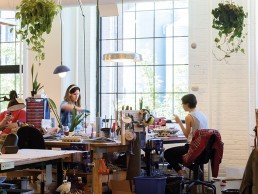
Having grown up in the Eastern Townships of Quebec, Canada, where his mother was a painter and father a ceramic artist, Lambert recalls how he was often left to his own devices… how there was always a lot of “stuff” around the house and in his parents’ studios – he soon became fascinated with the way things worked, how they were designed and was, according to his mother, re-assembling bicycle parts and toasters before he could read. “As a teenager I started working with my father’s kiln,” he says. “So that pulse of ideas, creating and making is a big part of who I am – it’s been with me for a long time.”
While the studio is now well established within the design industry, lighting isn’t an area that has always played a part in Lambert’s career, “for more than 20 years I worked in film and contemporary art,” he says. “Then, when I was almost 40 and my wife and I were expecting our first child together, there was a shift. I felt an urge to return to the basics, create something that I could dedicate myself to – I had this recurring feeling of wanting to make my son proud.
“It was a turning point for me. I’d always dreamed of having my own design studio, where I could conceptualise and create pieces; set down roots in a creative community like my father had done in the 70s. I quit my job and opened up shop in a small storefront on Beaubien St in Montreal. It was a full-circle moment for me… amidst all these reflections on legacy I named the shop Lambert & Fils (Lambert & Sons).”
Form is a huge component of Lambert & Fils’ work, particularly as the team begins to debut more contemporary lighting collections in more contemporary materials. The studio looks for ways to breathe new life into classic, archetypal shapes – creating dialogues between opposing materials, playing with scale and dimension.
“Materials have always been an anchor of my creative process,” continues Lambert. “In the original Beaubien location I split the shop into two sections – mid-century modern furnishings and in-house lighting that I started designing as I came across beautiful vintage materials such as coloured glass, milk glass and polished brass. I did a lot of custom work but it started to feel too complicated and I wanted to streamline the ideas into cohesive collections.”
This is where the Lambert & Fils Waldorf Collection was born. Combining an open hemispherical shade with a cylindrical socket cover, this composite shade is deployed in suspension and wall-mounted configurations with natural brass and powder-coated rods. As time has gone on the studio’s focus has shifted solely to lighting and many of its collections since have featured that nod to the past, invoking a vintage, romantic feeling into contemporary designs.
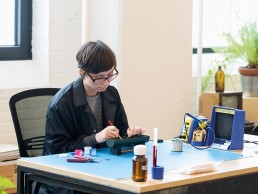
“We are inspired by the collective memory of the past and the future possibilities of lighting design,” says Lambert. “Through installations and exhibitions, we explore where our artistic and design practices can meet.
“Lambert & Fils is not about spectacle or fireworks. Our designs are composed of simple, honest gestures that feel meaningful and timeless to us. Behind all our own work is a reflection on form and materials; aesthetically, that shines through the design itself. I think our lighting makes you think about the many shapes of life – it aims to tap into a collective memory of architectures and objects.
“Even though we design our own collections, we also define ourselves as a collaborative lighting studio. We work with designers internationally to transform ideas and prototypes into collections. We challenge where art and design intersect through provocative lighting installations and exhibitions. On our own team, a design blossoms over time between different designers and editors. The creative visions are collective and constantly under investigation.”
One of Lambert & Fils’ latest collections, heading to Milan Design Week this year, is a wonderfully playful collection – Hutchison is a study of soft curves and hard lines, presenting a rivalry of vertical and horizontal forces, a play of scale and repetition.
“We summoned the archetypal shapes of Middle Eastern archways and Roman terracotta roofs,” explains Lambert. “Experimenting with how we could breathe these iconic forms into a contemporary pendant light.
“Alongside our new Sainte collection, Hutchison also continues our ongoing conversation with modular lighting. Alone, it self-defines as a very frank and decorative lamp, but in multiples, it invokes those classic architectures of columns, arches and pillars. This is what I mean when I say that as a studio, we’re interested in stirring a collective memory of shapes and forms.
“The Hutchison collection is a result of simple and honest gestures – it’s a piece that – at least for me – resonates in the mind long after leaving it.”
Each Hutchison pendant is composed of an aluminium base with a matte, textured finish that pivots attention to its contours and lines. Visually prominent suspension wires made from waxed cotton contrast the dense horizontal base – an interplay of mass and lightness.
“Aluminum was chosen for its flexibility, which was necessary to create the curves in the base,” says Lambert. “Initially, we looked into molding the forms and even considered concrete, but we found it was tricky to get the exact curves we were envisioning. Achieving the right angle was so critical and aluminium gave us the freedom to perfect the shape. For this fixture, we used our custom LED board that we designed in-house. We wanted the light to have multiple moods – being able to go from dim to warm and supply various forms of ambient light.
“We chose the matte textured paint on the aluminium because the curves can be highly reflective and transform the object under different shadows of light. We wanted to limit this and turn the focus to the form itself and the matte finish helped us achieve this effect.”
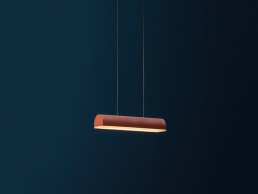
Lambert’s fascination with the iconic shapes explored in Hutchison came from an “overdose of seeing the archway shape being exploited in so many interior scenographies.” While it is a timeless form, he tells darc how he felt many iterations of it were being used superficially, “as sort of a trend component, not engaging with the history and collective memory of the shape itself,” he says. “That is what sparked Hutchison. I wanted to find something new in this form – a style exercise in how to aply the architecture of an archway into a lamp.”
For Lambert, most types of design involve the interaction of function and form and it couldn’t be more true for lighting design, which has so many considerations beyond the way it actually looks.
“There are so many components to take into account when creating fixtures – light quality and control, installation and wiring, the interaction of different materials and their light source,” he says. “The benefit of producing our designs in-house is being able to keep an eye on these considerations. We think about the people who will interact with the light over time and also the many types of spaces.
“Technology is also a big component of lighting design, something that always keeps designers on their toes. For instance, in the beginning, lighting design was appealing to me because it was easy to create spectacular effects with incandescents. When LED technolocy came around, it became more complex, but also more exciting – we now build our own custom LED boards to bolster the functionality of our designs.
“Ultimately, lighting should impose a scaling factor and function for all kinds of spaces, creating dimension and texture with any kind of ceiling height,” Lambert concludes. “Lighting should be dynamic and create a different ambience depending on the time of day. Lighting is a room’s link with intimacy, warmth, glow… it defines a space in how it creates forms through shadows and shine – it is the design component that can unlock the magic hidden within a room.”
Tribeca - Alma Light Barcelona
Designed by Jordi llopis, Tribeca is made of alabaster & iron, with a retro and minimalist look. Each shade is unique, thanks to the white and gray veins with some earth-colour touches. The alabaster gives a spectacular look when the light is on and a beautiful appearance when off. The structures are simple, contrasting with the heaviness of the stone. A perfect balance between weight and lightness.
What is the concept behind Tribeca?
The Tribeca range is made using alabaster stone, which is found in Spanish quarries and has a long tradition in our country; I discovered it while visiting a small workshop two hours south of Barcelona. The stone gives each shade a unique identity, featuring white and grey tones and sometimes even creating a more earthy colour… I wanted to use the lighting range to highlight alabaster’s wonderful design properties and bring a focus back on using the stone in design – it also works wonderfully with light. Each piece is fascinating and has a soft translucency to it.
How long have you been working with Almalight?
I have been aware of Almalight for a number of years but we have never known each other on a personal level until this project. Once I met the team, there was an instant connection and I understood the brand's design philosophy from the beginning.
How many pieces does the collection include?
I have developed three different ceiling pieces – the first is a pendant with just one shade, then there is a pendant with two overlapping shades and there is also a ceiling piece that features four shades and linear ceiling plate. As well as this, there are two floor fixtures, where again, there is the option of having one light shade or two; all of the options use dimmable LED technology.
What makes Tribeca different?
Personally, I think choosing the alabaster has given the collection a strong personality but most of all I am proud of the properties of the material that ‘tame’ the light – for me this is the most important aspect when you are designing a lighting piece.
What kind of environment is this product range suitable for?
The alabaster conveys a great deal of warmth and gives a spectacular look when the light is turned on, as well as a wonderful appearance when it is off. The style of the collection fits perfectly into many different interior design schemes… with Tribeca we are creating a trend. While the structures are simple, contrasting with the ‘heaviness’ of the stone – Tribeca finds a perfect balance in the contrast between weight and lightness.
Describe the Tribeca range in three words?
Warm, sincere, without stridence.
Who inspires your designs?
A little more than a year ago, my father passed away followed by mother in April. They taught me everything I know about life and supported me in my design career – for this I thank them. Even during the more difficult times in my career, their support was constant – they remain my role models and inspiration in all areas of my life.


